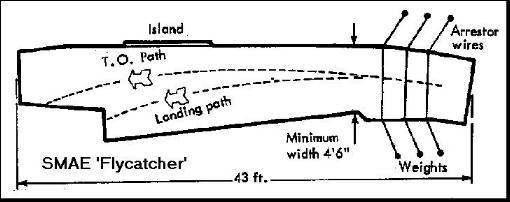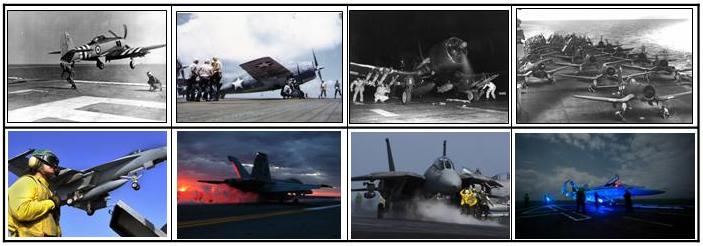Here’s the UK specification for a simulated carrier deck for competitions. If no raised deck is available, the dimensions can be marked out on the ground and arresting cables set up to suit.
| 1 | Deck Centreline Length: | 27ft 6in (8.4m) excluding stern ramp | |
| 2 | Deck Centreline Curved to: | 60ft (18.3m) radius | |
| 3 | Deck Width: | 5ft (1.5m); | |
| 4 | Stern Ramp Height: | 1ft 2in (0.35m) | |
| 5 | Stern Ramp Slope: | 4ft (1.2m) measured down slope | |
| 6 | Arrester wire details: |
a) 4 wires supported 1” (25mm) above the deck b) each wire to be 16ft (4.9m) long c) each wire to have a 5 lb (2.5kg) sandbag (or other suitable arresting drag) attached to each end d) the No.1 wire should be located perpendicular to the deck centreline at a distance of 4ft (1.2m) forward from the ramp top e) The remaining wires should be perpendicular to the centreline and spaced at 2ft 8in (0.8m) intervals |
Here’s an interesting diagram of the original UK deck sponsored by the Fleet Air Arm in the 1960s (bigger than the current minimum), giving a good idea of the layout..

…and just for comparison, here are some pictures of the real thing. Let’s not forget the bravery and dedication of the guys and girls that do this for real.
A pal of mine, a Sea King helicopter pilot who flew from the old HMS Ark Royal, told me: “It’s an incredible buzz – the smell of kerosene, the turn and burn, every landing a potential disaster, the guts of the jet pilots landing on a deck heaving up and down after night ops in the worst weather, a whole ship working as a team with no room for mistakes. It’s the most dangerous working environment on the planet – and I loved every minute of it!”


